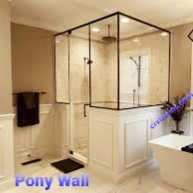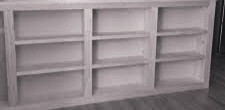Pony wall is a low height partition. It does not bear any load. This type of wall is constructed to devide large area into small areas. Its height never touch the slab.
Various building materials used to make pony walls. The most common materials are wood, gypsum board, cement board, steel and lightweight concrete blocks. These walls are about one meter high and effectively divide the space inside and throughout the interior space.
See the below image of pony wall.

Pony Wall is a flexible building material that can be used anywhere in your home. Pony walls can be found in each room, such as entryways, bathrooms, parlors, and bedrooms. Divide large areas into smaller areas while maintaining an open and airy feel. Additionally, walls are often used as safety rails at the top of stairs.
Pony walls, like regular walls, have top and bottom panels, which are horizontal members to which vertical posts are attached.
Table of Contents
How to Construct Pony Wall
Construction process of pony wall is very easy. I have described the step by step construction procedure of pony wall.
- Before you build your pony wall, plan its location. This method is suitable for large interior walls in pathmaker designs.
- The most important factor is length. The entire room can be covered with a half-wall design, or only part of it. You can also build a wall near another wall or build two walls of him with a gap in between.
- Pony Walls can be built so that the studs line up with the joist directly below. If the half wall extends from the foundation wall, the studs should be placed below the overhead joist.
- Pony Wall Surface Enhancement is permitted if walls exceed 3-4 feet.
- Make sure all vertical boards have a constant length. The next step is to cut the top and bottom plates to the same length.
- After marking the top and bottom boards, attach the vertical boards with screws.
- Pony Wall is easy to assemble. It must be fixed in place and placed on at least one wall. Draw lines across the surface to keep the floor level. Place it there and secure it to the floor with screws.
- It is best to screw the wall to the main wall. Also, there are some support positions.
- If the ponywall is designed to cover the entire width of the floor, it is recommended that it be screwed into both main walls at both ends.
Diffrent Types of Pony Walls
1. Shower Pony Wall
Shower pony wall is used in washroom. It is used to separate bathing area and toilet area. Maintaining a pony wall near the toilet adds a sense of privacy. It can also separate two rooms. If you take a shower, covering it with glass will make the room more unique.

2. Load Bearing Ponywall
Ponywalls can also be used as load-bearing walls, sitting on foundation ties to support roof beams. These walls, commonly called crippled walls, support the entire structure and transfer weight to the foundation.

3. Pony Wall Bookshelf
There are two ways to use the Pony Wall as a bookshelf. The first approach is that the top of the wall can be removed and turned into a wall shelf, just leaving the slot empty. The second method is to store books with shelves on the pony wall.

4. Stair Pony Wall
This type of pony wall provides a stable base for adding railings and more wall space for displaying photos and artwork. Many architects build a wall along one side of the entrance rather than building a full wall on both sides of the staircase.

This type of construction prevents tipping, an important safety measure, and provides an ideal backdrop for placing furniture.
5. Entrance Pony Wall
A pony wall can be built between the main living area and the entrance to form a mud room. Store outdoor gear and shoes behind a wall. As a result, it is not visible from the living room. These walls also direct foot flow from the front door to the main area of the home. It extends into the kitchen, providing space to store dishes, more work surfaces, and dividers between rooms.

6. Pony Wall for Childs
The pony wall is perfect for creating a separate space for smaller children. In addition, pony walls can be used to divide the number of rooms and create play areas in other home spaces. can be difficult to do. Pony walls can be used to separate rooms for different purposes.

Benefits of Pony Walls
- Pony walls can be constructed in almost any way to suit your particular home design.
- Pony Wall provides easy access and natural light into the room.
- Pony walls provide boundaries between rooms and areas of your home without feeling dark or confining.
Pony Wall Disadvantages
- Pony walls can make your home look smaller by dividing it into smaller areas.
- Pony walls can make small spaces like bathrooms feel less private.
